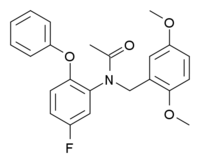DAA-1106
 | |
| Systematic (IUPAC) name | |
|---|---|
| N-(2-phenoxy-5-fluorophenyl)-N-(2,5-dimethoxybenzyl)acetamide | |
| Clinical data | |
| Identifiers | |
| 220551-92-8 | |
| PubChem | CID 10430788 |
| ChemSpider | 8606215 |
| Chemical data | |
| Formula | C23H22FNO4 |
| 395.423 g/mol | |
|
SMILES
| |
| |
| | |
DAA-1106 is a drug which acts as a potent and selective agonist at the peripheral benzodiazepine receptor, also known as the mitochondrial 18 kDa translocator protein or TSPO, but with no affinity at central benzodiazepine receptors. It has anxiolytic effects in animal studies.[1][2][3] DAA-1106 has a sub-nanomolar binding affinity (Ki) of 0.28nM, and has been used extensively in its 3H or 11C radiolabelled form to map TSPO in the body and brain, which has proved especially helpful in monitoring the progress of neurodegenerative diseases such as Alzheimer's disease.[4][5][6][7][8][9]
References
- ↑ Okuyama S, Chaki S, Yoshikawa R, Ogawa S, Suzuki Y, Okubo T, Nakazato A, Nagamine M, Tomisawa K (1999). "Neuropharmacological profile of peripheral benzodiazepine receptor agonists, DAA1097 and DAA1106". Life Sciences 64 (16): 1455–64. doi:10.1016/S0024-3205(99)00079-X. PMID 10321725.
- ↑ Okubo T, Yoshikawa R, Chaki S, Okuyama S, Nakazato A (January 2004). "Design, synthesis and structure-affinity relationships of aryloxyanilide derivatives as novel peripheral benzodiazepine receptor ligands". Bioorganic & Medicinal Chemistry 12 (2): 423–38. doi:10.1016/j.bmc.2003.10.050. PMID 14723961.
- ↑ James ML, Selleri S, Kassiou M (2006). "Development of ligands for the peripheral benzodiazepine receptor". Current Medicinal Chemistry 13 (17): 1991–2001. doi:10.2174/092986706777584979. PMID 16842193.
- ↑ Venneti S, Lopresti BJ, Wang G, Slagel SL, Mason NS, Mathis CA, Fischer ML, Larsen NJ, Mortimer AD, Hastings TG, Smith AD, Zigmond MJ, Suhara T, Higuchi M, Wiley CA (September 2007). "A comparison of the high-affinity peripheral benzodiazepine receptor ligands DAA1106 and (R)-PK11195 in rat models of neuroinflammation: implications for PET imaging of microglial activation". Journal of Neurochemistry 102 (6): 2118–31. doi:10.1111/j.1471-4159.2007.04690.x. PMID 17555551.
- ↑ Venneti S, Wang G, Nguyen J, Wiley CA (October 2008). "The positron emission tomography ligand DAA1106 binds with high affinity to activated microglia in human neurological disorders". Journal of Neuropathology and Experimental Neurology 67 (10): 1001–10. doi:10.1097/NEN.0b013e318188b204. PMC 2669281. PMID 18800007.
- ↑ Ji B, Maeda J, Sawada M, Ono M, Okauchi T, Inaji M, Zhang MR, Suzuki K, Ando K, Staufenbiel M, Trojanowski JQ, Lee VM, Higuchi M, Suhara T (November 2008). "Imaging of peripheral benzodiazepine receptor expression as biomarkers of detrimental versus beneficial glial responses in mouse models of Alzheimer's and other CNS pathologies". Journal of Neuroscience 28 (47): 12255–67. doi:10.1523/JNEUROSCI.2312-08.2008. PMC 2755188. PMID 19020019.
- ↑ Doorduin J, de Vries EF, Dierckx RA, Klein HC (2008). "PET imaging of the peripheral benzodiazepine receptor: monitoring disease progression and therapy response in neurodegenerative disorders". Current Pharmaceutical Design 14 (31): 3297–315. doi:10.2174/138161208786549443. PMID 19075709.
- ↑ Gulyás B, Makkai B, Kása P, Gulya K, Bakota L, Várszegi S, Beliczai Z, Andersson J, Csiba L, Thiele A, Dyrks T, Suhara T, Suzuki K, Higuchi M, Halldin C (January 2009). "A comparative autoradiography study in post mortem whole hemisphere human brain slices taken from Alzheimer patients and age-matched controls using two radiolabelled DAA1106 analogues with high affinity to the peripheral benzodiazepine receptor (PBR) system". Neurochemistry International 54 (1): 28–36. doi:10.1016/j.neuint.2008.10.001. PMID 18984021.
- ↑ Wang M, Gao M, Hutchins GD, Zheng QH (June 2009). "Synthesis of [11C]FEDAA1106 as a new PET imaging probe of peripheral benzodiazepine receptor expression". European Journal of Medicinal Chemistry 44 (6): 2748–53. doi:10.1016/j.ejmech.2008.08.001. PMID 18790550.